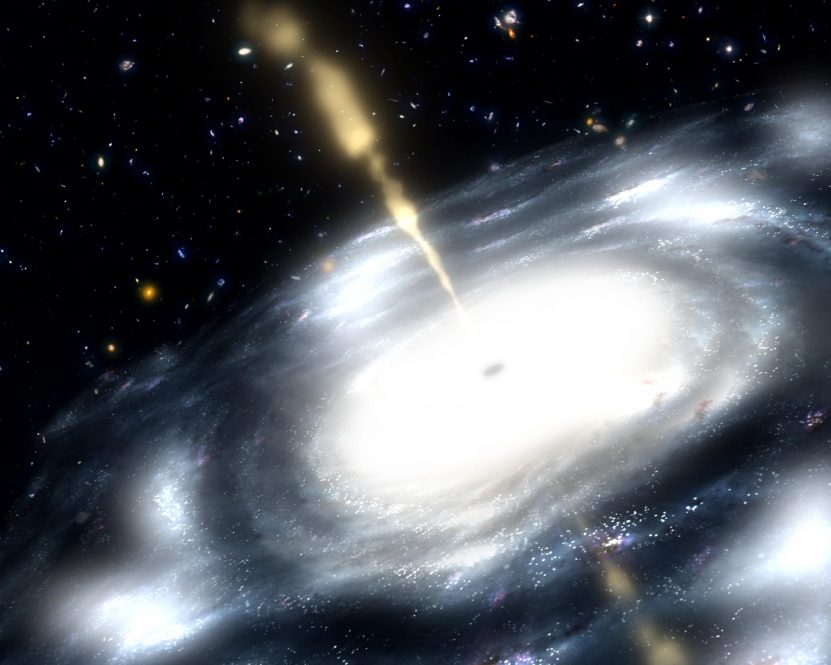Throughout the universe, galaxies are merging. This process creates supermassive black holes a billion times the mass of our sun – or at least scientists suspect it does.
Scientists have not yet been able to prove the existence of these supermassive black hole mergers, or binaries. Chiara Mingarelli, assistant professor of physics, was the lead researcher on a $650,000 Collaborative Research Grant from the National Science Foundation, half of which is earmarked for UConn, to conduct an experiment to prove the existence of supermassive black hole binaries.
Researchers at the Laser Interferometer Gravitational Wave Observatory (LIGO) have detected high-frequency gravitational waves indicating the existence of small black hole binaries. These frequencies are in the 100 hertz range. Mingarelli is looking for waves at the nanohertz frequency range – more than a billion times lower than the waves LIGO can detect.
These smaller black holes can get much closer to each other before they merge, and scientists can usually see the merger for a fraction of a second. The black holes that interest Mingarelli create such strong gravitational waves that the mergers can be seen millions of years before they happen, and occur at much lower frequencies.
“At very high frequencies you see the very last blip of the life of these tiny black hole mergers,” Mingarelli says. “With NANOGrav – a Pulsar Timing Array experiment– you see the last 25 million years of their lives because the gravitational waves are so big.”
Currently, there is no evidence that supermassive black holes merge, or, if they do, how they merge, what causes them to merge, and what their gravitational waves look like.
Mingarelli’s experiment will address these questions through “multi-messenger science,” an approach that uses both light signals and gravitational wave signals to understand the full picture of these epic events.
“We’re really spoiled in a sense, because the supermassive black holes are in massive galaxies and those can be really bright, so we know where to look,” Mingarelli says. “The more data you can get about systems that are as rare as supermassive black holes that are merging, the better.”
This light information will come from looking at active galactic nuclei (AGN). AGN are the centers of black holes that are gaining mass and shooting off bright jets of light. Combining AGN and gravitational wave data will allow Mingarelli and her team at UConn to estimate how many supermassive black holes are merging and contributing to the gravitational wave background.
This grant will combine, for the first time, traditional astronomy with gravitational wave astronomy putting Mingarelli and the students in her lab on the cutting edge of astrophysics.
“UConn students are really going to be at the forefront of gravitational wave research in the world,” Mingarelli says. “This could really transform our knowledge of supermassive black hole mergers.”
This novel approach will allow Mingarelli to reverse engineer a comprehensive model of the supermassive black hole binaries in the universe.
Traditionally, scientists have tied the gravitational wave background to theoretical galaxy merger rates. Mingarelli’s approach provides a much more grounded set of measurements as actual galaxy mergers produce observable AGNs.
Jenny Greene, professor astrophysical sciences at Princeton University, and Co-PI on the grant, will be responsible for identifying additional AGNs. With this new data, Mingarelli’s group will make new predictions about the amplitude of the gravitational wave background.
Through this work, Mingarelli will produce a ranking of galaxies from most to least likely to have a supermassive black hole binary.
“This project is really setting up a whole new way to think about low-frequency gravitational-wave and extragalactic astronomy,” Mingarelli says. “With our new method, not only can we make predictions about the amplitude of the gravitational wave background, but we can also make predictions of where the likeliest and closest supermassive black hole systems are.”
Mingarelli and her students will work with high school students in Connecticut, New Jersey, and New York on this project.
The students will contribute to the research by identifying new pulsars with the Pulsar Search Collaboratory. Pulsars are cosmic “lighthouses.” They spin and send out flashes of radio waves to the earth at regular intervals. Gravitational waves, like those produced by supermassive black hole binaries, change the distance between objects. So, if a gravitational wave is moving through a galaxy, it will make the pulsars come closer to the earth and then further back again.
“It causes this wobble in space time,” Mingarelli says. “So, the pulsar pulses arrive early, and then late…and that’s how we can look for the gravitational wave signals that are coming from the supermassive black holes.”
The students will search for pulsars in radio astronomy data. The more pulsars we include in our Pulsar Timing Array experiment, the more information about the gravitational waves it can detect, meaning these students will be making a significant contribution to this cutting-edge scientific effort.
“Sometimes, in some marginalized communities, students don’t even know they can be scientists, they don’t know they can think about black holes for a living,” Mingarelli says. “Exposing them to the opportunity to take part in fundamental research is really important, in my opinion, as is helping students to understand science as a career is a possibility.”
Mingarelli holds a Ph.D. from the University of Birmingham. She is also a research scientist at the Center for Computational Astrophysics at the Flatiron Institute.



